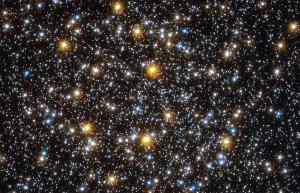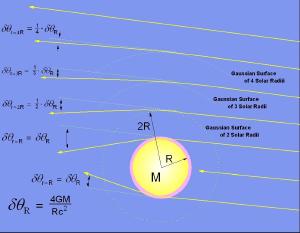Blog
Wandering Stars
24 September 2014
 NASA
NASAOne of the consequences of general relativity is that light can be deflected by nearby masses. Mass curves space, and this curvature causes light to bend slightly. It was first observed during a total eclipse in 1919. The effect is extremely small unless the light passes close to a large mass, so gravitational lensing (as it is typically known) is usually only noticed with objects such as lensed galaxies, or specific tests of general relativity. But even though the effect is small as you get further from a mass, it isn’t zero. As our astronomical measurements become more precise, the effects of gravity are starting to become something we can’t ignore.
 Wikipedia
WikipediaThe deflection of light by the Sun’s gravity isn’t a binary thing. It is largest when light grazes the surface of the Sun, but gets gradually smaller with distance. Even with starlight well clear of the Sun, there is a small deflection. At Earth’s distance, the light of a star seen at a direction 90 degrees away from the Sun is deflected by 4 milliarcseconds. That’s an extraordinarily tiny shift, and usually one you can ignore. But when we launched the Hipparcos satellite in 1989, it was capable of measuring the positions of stars to about 3 milliarcseconds. Over its lifetime it measured about 3.5 million relative positions of stars. Since they were taken at different angular separations from the Sun, these measurements have varying gravitational deflections. The effect can be seen in the data, and can even be used to confirm Einstein’s prediction to within about 0.3%.
When the Gaia spacecraft comes online, the effect will be even more clear. Gaia will measure the positions of about a billion stars, and has an accuracy of about 24 microarcseconds. At that point the affects of gravity aren’t just a minor statistical fluctuation, but are in fact a major effect that must be corrected. One upside of this is that the Gaia data can be used to test light bending in general relativity to a greater precision than we have so far.
No one expects that Gaia will fail to confirm general relativity, but it does demonstrate just how precise modern astronomy has gotten. An effect that could barely be detected under the best conditions a century ago has now become a major factor in the apparent wandering of stars in our data.